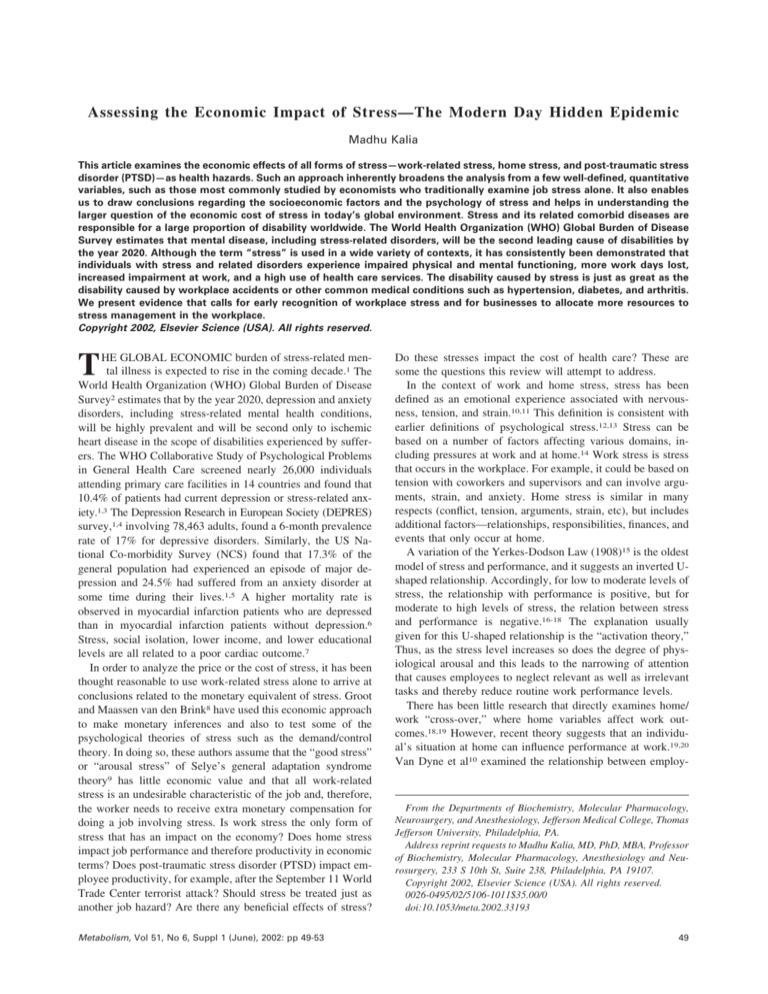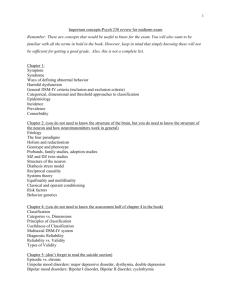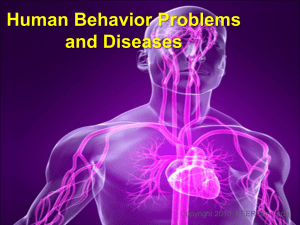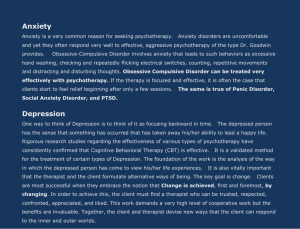
Assessing the Economic Impact of Stress—The Modern Day Hidden Epidemic
Madhu Kalia
This article examines the economic effects of all forms of stress—work-related stress, home stress, and post-traumatic stress
disorder (PTSD)—as health hazards. Such an approach inherently broadens the analysis from a few well-defined, quantitative
variables, such as those most commonly studied by economists who traditionally examine job stress alone. It also enables
us to draw conclusions regarding the socioeconomic factors and the psychology of stress and helps in understanding the
larger question of the economic cost of stress in today’s global environment. Stress and its related comorbid diseases are
responsible for a large proportion of disability worldwide. The World Health Organization (WHO) Global Burden of Disease
Survey estimates that mental disease, including stress-related disorders, will be the second leading cause of disabilities by
the year 2020. Although the term “stress” is used in a wide variety of contexts, it has consistently been demonstrated that
individuals with stress and related disorders experience impaired physical and mental functioning, more work days lost,
increased impairment at work, and a high use of health care services. The disability caused by stress is just as great as the
disability caused by workplace accidents or other common medical conditions such as hypertension, diabetes, and arthritis.
We present evidence that calls for early recognition of workplace stress and for businesses to allocate more resources to
stress management in the workplace.
Copyright 2002, Elsevier Science (USA). All rights reserved.
T
HE GLOBAL ECONOMIC burden of stress-related mental illness is expected to rise in the coming decade.1 The
World Health Organization (WHO) Global Burden of Disease
Survey2 estimates that by the year 2020, depression and anxiety
disorders, including stress-related mental health conditions,
will be highly prevalent and will be second only to ischemic
heart disease in the scope of disabilities experienced by sufferers. The WHO Collaborative Study of Psychological Problems
in General Health Care screened nearly 26,000 individuals
attending primary care facilities in 14 countries and found that
10.4% of patients had current depression or stress-related anxiety.1,3 The Depression Research in European Society (DEPRES)
survey,1,4 involving 78,463 adults, found a 6-month prevalence
rate of 17% for depressive disorders. Similarly, the US National Co-morbidity Survey (NCS) found that 17.3% of the
general population had experienced an episode of major depression and 24.5% had suffered from an anxiety disorder at
some time during their lives.1,5 A higher mortality rate is
observed in myocardial infarction patients who are depressed
than in myocardial infarction patients without depression.6
Stress, social isolation, lower income, and lower educational
levels are all related to a poor cardiac outcome.7
In order to analyze the price or the cost of stress, it has been
thought reasonable to use work-related stress alone to arrive at
conclusions related to the monetary equivalent of stress. Groot
and Maassen van den Brink8 have used this economic approach
to make monetary inferences and also to test some of the
psychological theories of stress such as the demand/control
theory. In doing so, these authors assume that the “good stress”
or “arousal stress” of Selye’s general adaptation syndrome
theory9 has little economic value and that all work-related
stress is an undesirable characteristic of the job and, therefore,
the worker needs to receive extra monetary compensation for
doing a job involving stress. Is work stress the only form of
stress that has an impact on the economy? Does home stress
impact job performance and therefore productivity in economic
terms? Does post-traumatic stress disorder (PTSD) impact employee productivity, for example, after the September 11 World
Trade Center terrorist attack? Should stress be treated just as
another job hazard? Are there any beneficial effects of stress?
Metabolism, Vol 51, No 6, Suppl 1 (June), 2002: pp 49-53
Do these stresses impact the cost of health care? These are
some the questions this review will attempt to address.
In the context of work and home stress, stress has been
defined as an emotional experience associated with nervousness, tension, and strain.10,11 This definition is consistent with
earlier definitions of psychological stress.12,13 Stress can be
based on a number of factors affecting various domains, including pressures at work and at home.14 Work stress is stress
that occurs in the workplace. For example, it could be based on
tension with coworkers and supervisors and can involve arguments, strain, and anxiety. Home stress is similar in many
respects (conflict, tension, arguments, strain, etc), but includes
additional factors—relationships, responsibilities, finances, and
events that only occur at home.
A variation of the Yerkes-Dodson Law (1908)15 is the oldest
model of stress and performance, and it suggests an inverted Ushaped relationship. Accordingly, for low to moderate levels of
stress, the relationship with performance is positive, but for
moderate to high levels of stress, the relation between stress
and performance is negative.16-18 The explanation usually
given for this U-shaped relationship is the “activation theory,”
Thus, as the stress level increases so does the degree of physiological arousal and this leads to the narrowing of attention
that causes employees to neglect relevant as well as irrelevant
tasks and thereby reduce routine work performance levels.
There has been little research that directly examines home/
work “cross-over,” where home variables affect work outcomes.18,19 However, recent theory suggests that an individual’s situation at home can influence performance at work.19,20
Van Dyne et al10 examined the relationship between employ-
From the Departments of Biochemistry, Molecular Pharmacology,
Neurosurgery, and Anesthesiology, Jefferson Medical College, Thomas
Jefferson University, Philadelphia, PA.
Address reprint requests to Madhu Kalia, MD, PhD, MBA, Professor
of Biochemistry, Molecular Pharmacology, Anesthesiology and Neurosurgery, 233 S 10th St, Suite 238, Philadelphia, PA 19107.
Copyright 2002, Elsevier Science (USA). All rights reserved.
0026-0495/02/5106-1011$35.00/0
doi:10.1053/meta.2002.33193
49
50
MADHU KALIA
ees’ home stress and their behavior at work and found that
home stress is negatively related to routine performance at
work.
The definition of stressors should include careful, behaviorally anchored terminology, and use of imprecise jargon should
be avoided. In addition, when measuring the stressor, the exposure should be measured independently of the symptoms
exhibited in reaction to the exposure. The timing and intensity
of the exposure should be determined since the reaction could
occur long after the initial exposure.
Organizational scholars and economists have long been interested in stress12,17,21 and have focused on examining task,
job, and work stress in particular. More recently, research in the
context of work and family issues has examined the relationship between home-related stress and several other outcomes
such as home-life satisfaction and workplace satisfaction.11,19,20 Although work stress is the most commonly studied
form of stress, other types of stress such as home stress, trauma
leading to post-traumatic stress syndrome, and anxiety need to
be included in any comprehensive analysis of stress-related
outcomes.
THE HIGH COST OF STRESS
The misdiagnosis of stress-related disorders, including anxiety, costs the United States billions of dollars each year (Table
1). With more than 19 million Americans inflicted each year,
anxiety disorders are the most common form of mental illnesses, yet less than one third of affected people receive appropriate treatment. Stress-related disorders cost the nation
more than $42 billion per year. More than half of that is due to
the repeated use of health care services. In fact, studies have
shown that people suffering from stress-related illnesses are 3
to 5 times more likely to visit the doctor and 6 times more
likely to be hospitalized than nonsufferers. In addition, approximately 43% of these people are also depressed or have alcohol
or substance abuse problems.
JOB STRESS
Although the relationship between stress and health care
costs is receiving considerable attention, the true price tag is far
greater than that of health care alone. Most organizations do not
have an accurate assessment of how much employee stress
costs them each year. Stress has been shown to add to the cost
of doing business in a number of ways. Some of the serious
consequences of employee stress are absenteeism, Worker’s
Compensation claims, litigation, grievances, accidents, errors
of judgment and action, conflict and interpersonal problems,
violence, customer service problems, resistance to change, no
time to do it right, and loss of intellectual capital.
The American Institute of Stress has determined that 75% to
90% of all doctor visits are now stress-related. The Property
and Casualty Insurance Edition of Best’s Review estimates that
$150 billion of revenue is lost to stress annually in lost productivity, absenteeism, poor decision-making, stress-related
mental illness, and substance abuse. In addition, the same
edition of Best’s Review reports that 1 of 4 American workers
suffer a mental health problem rooted in stress. The Washington Business Group on Health has found that 46% of all
employees are severely stressed to the point of burnout. Stress
leads to anxiety, which leads to 15% of doctors’ patients and
33% of Americans suffering from insomnia.22 With regard to
heart disease, it has been estimated that the yearly costs of
treatment and lost productivity are $117 billion and that 13.5
million people are affected.23
Several studies funded by the National Institute of Occupational Safety Health (NIOSH) have examined the effect of job
stress on health.22 A few suggest that psychologically demanding jobs that allow employees little control over the work
process increase the risk of cardiovascular disease. On the basis
of research by NIOSH and many other organizations, it is
widely believed that job stress increases the risk for development of back and upper-extremity musculoskeletal disorders.
Several studies suggest that differences in the rates of mental
Table 1. Statistics
Source
Foster Higgins, Co
The California Workers
Compensation Institute
Maine Bureau of Labor
Statistics
American Journal of
Health Promotion
Heath Benefits
(% of
after-tax profit)
Stress (% of
all health care
problems)
45%
60%-90%
Workman’s Comp
Stress Claims
Absenteeism
Consequences of
Absenteeism
Accidents
700% increase between
1979-1988
1,000% increase since
1985
2 times more
likely to be
absent more
than 5 times
a year
Lost productivity
and replacement
costs
Harvard Business Review
NOTE. Data represent the effect of stress on healthcare and economics for the most recent published studies indicated.
Highly stressed
workers are
3% more
likely to have
accidents
ECONOMIC IMPACT OF STRESS
health problems (such as depression and burnout) for various
occupations are due partly to differences in job stress levels.
Economic and lifestyle differences between occupations may
also contribute to some of these problems. NIOSH suggests that
there is growing concern that stressful working conditions
interfere with safe work practices and set the stage for injuries
at work. Some studies indicate a possible relationship between
stressful working conditions and these health problems. However, more research is needed before firm conclusions can be
drawn. Some of the early warning signs of job stress are
headache, sleep disturbances, difficulty in concentrating, short
temper, upset stomach, job dissatisfaction, and low morale.
51
Table 2. Differences Between HPA Axis Alterations in PTSD
and Chronic Stress/Depression
PTSD
Chronic Stress/Depression
Increased CRF release
Decreased levels of cortisol
Increased CRF release
Increased levels of
cortisol
Decreased glucocorticoid
receptor responsiveness
Weaker negative feedback
inhibition
Increased glucocorticoid
receptor responsiveness
Stronger negative feedback
inhibition
Abbreviation: CRF, corticotropin-releasing factor.
Reprinted with permission.34
Psychosocial Factors in Job-Related Stress
NIOSH has been concerned with these issues since 1986.23
At that time, NIOSH stated that more information was needed
on the association between work-related psychosocial factors
and the development of cardiovascular disease. This research
could focus on several factors, such as machine pacing of work,
work overload (eg, holding 2 jobs), work organization, jobdecision latitude, and various aspects of stress at work. The
potential for new technologies such as computer-mediated
work were expected to increase job-related stress on workers.
NIOSH has redefined Hans Selye’s extreme response of the
general adaptation syndrome as stress.24 The moderate response, described by Selye as “arousal,” is described by
NIOSH as “challenge.” NIOSH defines stress as the harmful
physical and emotional responses that occur when the requirements of the job do not match the capabilities, resources, or the
needs of the worker. Job stress can lead to poor health and even
injury. The concept of job stress, according to NIOSH is often
confused with challenge, but these concepts are not the same.
Challenge energizes us psychologically and physically, and it
motivates us to learn new skills and master our jobs. When a
challenge is met we feel relaxed and satisfied. Thus, challenge
is an important ingredient for health and productive work. The
importance of challenge in our work lives is what NIOSH
believes is the same as “a little bit of stress is good for you.”
There is general agreement on the fact that job stress results
from the interaction of the worker and the conditions at work.
There are differing views about the relative importance of
worker characteristics versus working conditions as the primary cause of job stress. NIOSH and the National Occupational
Research Agenda (NORA) have recognized that the US workplace is changing and the workforce is becoming increasingly
diverse. The distribution of jobs in the US economy continues
to shift from manufacturing to services. Longer hours, compressed work weeks, shift work, reduced job security, and
part-time and temporary work are realities of the modern workplace. By the year 2005, the US workforce will grow to an
estimated 147 million, with minorities representing 28% of the
workforce and women representing approximately 48%.25
events can cause similar neuroses, the terms “traumatic neurosis” and later “post-traumatic stress disorder” (PTSD) were
coined.27,28 These new terms are meant to encompass the
broader view of traumatic stress, which includes conditions
such as a severe automobile accident, violent personal assault
(eg, rape, physical attack, robbery, mugging), terrorist attack,
natural or man-made disaster (such as a fire), witnessing serious
injury or death due to any of the above, as well as other
situations, such as being kidnapped or being held hostage.
PTSD is not a normal response to these traumatic events but
is considered to be a pathological response since the individual
is unable to adapt and go on with a normal life after an initial
period (no longer than 1 month). It has been estimated that
approximately one third of the population will be exposed to a
severe trauma during their lifetime.29,30 Of these individuals,
10% to 20% will develop PTSD,31 which makes the prevalence
of PTSD in the general population to be in the range of 3% to
6%. This has been confirmed by a recent study in the United
States.32 Yet, most patients are not being diagnosed and are
consequently not being treated. There are 4 characteristics of
PTSD: exposure to a traumatic event, re-experiencing the traumatic event, avoidance including emotional anesthesia, and
increased arousal.28,33
Table 2 compares the hypothalamic-pituitary-adrenal (HPA)
axis alterations in PTSD with chronic stress/depression (see
VanItallie in this supplement).
Epidemiologic studies show that prevalence of trauma and
PTSD is substantial in modern society. Most people will experience a traumatic event at some point in their life and up to
25% of them will develop the disorder. Traumatic exposure and
PTSD have an impact on the individual’s health, health care
service utilization, and general functioning. Such effects result
in a considerable economic burden for the individual and for
the health care system and society as a whole.35
A recent study by Deykin et al36 has shown that PTSD alone
or in combination with depression has a direct negative relationship with physical health that, in turn, is associated with
more frequent use of primary health care services. This study
did not show that PTSD leads to inappropriate (eg, distressmotivated) use of services.
STRESS FOLLOWING TRAUMA
In the past, stress following trauma was associated mainly
with combat-related events and was called: “shell shock,”
“combat neurosis,” “soldier’s heart,” or “operational fatigue.”26
When it became evident that even noncombative traumatic
HOME STRESS
Van Dyne et al10 have developed a model for work stress and
home stress and found a strong relationship between home
stress and creativity and employee satisfaction at work. Their
52
MADHU KALIA
results provide the scientific rationale for the argument that
supportive supervision for the stress and positive moderating
influence of intrinsic motivation for the stress will result in
positive work outcomes. This study is one of the few to
examine the spillover from work to nonwork and the relationship between stress and employee creativity at work.
Home stress is an expanding, yet under-researched area in
which most of the work has addressed stress and well-being,
stress in the home/family domain, and stress from work to
nonwork. There has been relatively little research done on
examining the relation between stress and employee work
performance.13,18,19
MANAGING STRESS AND CONCLUSIONS
In the United Kingdom, the Mental Health Foundation reports that stress costs British industry 3 billion British pounds
per year.37 Most companies did not view stress as a mental
health problem. Macho environments in large corporations and
financial institutions are often hot-beds of stress and the highprofile nature of the job often means that mistakes can cost
large amounts of cash. The report found that new companies
were more often aware of the problems of stress and had set up
external counseling, shiatsu massage, discount sports facilities,
and a quiet room to relieve staff of stress. The businesses
involved in the study have called for a national campaign to
tackle stress and for an independent employee counseling service for firms employing more than 100 people. This British
study indicates that raising awareness through publications is
important in tackling this workplace challenge and that sharing
“good practice guidelines” within the business community is an
important step forward.
“Depression and anxiety disorders impose considerable burdens on the individual; and on society in terms of impairment
of daily activities and work productivity and cost to health care
providers.”1 Since stress is the most common underlying condition leading to depression and anxiety, there is an urgent need
for prevention, early intervention, increased recognition, and
treatment of stress and the related comorbid psychiatric and
medical conditions.38
REFERENCES
1. Lecrubier Y: The burden of depression and anxiety in general
medicine. J Clin Psychiatry 62:4-9, 2001 (suppl 8)
2. World Health Organization: The global burden of disease, in
Murray CJL, Lopez AD (eds): The Global burden of Disease. A
Comprehensive Assessment of Mortality and Disability From Diseases,
Injuries and Risk Factors in 1990 and Projected. Cambridge, MA,
Harvard School of Public Health, 1996
3. Goldberg DP, Yecrubier Y: Form and frequency of mental disorders across cultures, in Ustun TB, Sartorius N (eds): Mental Illness in
General Health Care. Chichester, UK, Wiley, 1995, pp 323-334
4. Lepine JP, Gastpar M, Mendelwicz J, et al: Depression inn the
community: The first pan-European study DEPRES (Depression Research in European Society). Int Clin Psychopharmacol 12:19-20, 1997
5. Kessler RC, McGonagle KA, Zhao S, et al: Lifetime and 12month prevalence of DSM-III-R psychiatric disorders in the United
States: Results from the National Co-morbidity Survey. Arch Gen
Psychiatry 51:8-19, 1994
6. Roose SP, Spatz E: Treating depression in patients with ischemic
heart disease: Which agents are best to use and avoid? Drug Safety
20:459-464, 1999
7. Shores MM, Pascualy M, Veith RC: Major depression and heart
disease: Treatment trials. Semin Clin Neuropsychiatry 3:87-101, 1999
8. Groot W, Maassen van den Brink H: The price of stress. J Econ
Psychol 29:83-103, 1999
9. Selye H: The Stress of Life. New York, NY, McGraw-Hill, 1936
10. Van Dyne L, Cummings A, Jehn KA: Pink Collar Artists: Home
and Work Stress Effects on Routine performance, Creativity and Satisfaction. Philadelphia, PA, Wharton School Manuscripts, 1998
11. Cooke RA, Rousseau DM: Stress and strain from family roles
and work role expectations. J Appl Psychol 69:252-260, 1984
12. Lazarus RS, Deese J, Osler SF: The effects of psychological
stress upon performance. Psychol Bull 49:293-317, 1952
13. Motowidlo SJ, Packard JS, Manning MR: Occupational stress:
Its causes and consequences for job performance. J Appl Psychol
71:618-629, 1986
14. Netemyer RG, Boles JS, McMurrian R: Development and validation of work-family conflict scales. J Appl Psychol 81:400-410,
1998
15. Yerkes R, Dodson J: The relationship between stimulus to
rapidity of habit formation. J Comp Neurol Psychol 18:459-482, 1980
16. Cohen S: After effects of stress on human performance and
social behavior: A review of research and theory. Psychol Bull 88:82108, 1980
17. McGrath JE: Stress and behavior in organizations, Dunnette MD
(ed): Handbook of Industrial and Organizational Psychology. Chicago,
IL, Rand McNally, 1976
18. Schuler RS: Definition and conceptionalization of stress in organizations. Organization Behav Hum Performance 25:184-215, 1980
19. Zedeck S: Work, Families and Organizations. San Francisco,
CA, Jossey-Bass, 1992
20. Frone MR, Russell M, Cooper ML: Antecedents and outcomes
of work-family conflict: Testing a model of the work-family interface.
J Appl Psychol 77:65-78, 1992
21. Kahn RL, Byosiere P: Stress in organizations, in Dunnettee MD,
Hough LM (eds): Handbook of Industrial and Organizational Psychology, vol 3 (ed 2). Palo Alto, CA, Consulting Psychologists Press, 1992,
pp 572-650
22. Stellman J (ed): Encyclopedia of Occupational Health and
Safety, vol 1. Geneva, Switzerland, International Labor Office, 1997
23. Proposed National Strategies for the Prevention of Leading
Work-Related Diseases and Injuries. Occupational Cardiovascular
Diseases. Washington, DC, DHHS (NIOSH) Publication No. 89132, 1986
24. Stress at Work. Washington, DC, DHHS (NIOSH) Publication
No. 99-101, 1999
25. National Occupational Research Agenda: Priorities for the 21st
Century. Washington, DC, Update May 2000
26. Zohar J, Sasson Y, Amital D, et al: Current diagnostic issues and
epidemiological insights in PTSD. CNS Spectrum 3:12-14, 1998
27. American Psychiatric Association: Diagnostic and Statistical
Manual for Mental Disorders (ed 3). Washington, DC, American Psychiatric Association, 1980
28. American Psychiatric Association: Diagnostic and Statistical
Manual for Mental Disorders (ed 4). Washington, DC, American Psychiatric Association, 1994
29. Solomon SD, Davidson JRT: Trauma, prevalence, impairment,
service use and cost. J Clin Psychiatry 58:5-11, 1997
30. Breslau N, Kessler RC, Chilcoat HD, et al: Trauma and posttraumatic stress disorder in the community: The 1996 Detroit Area
Survey of Trauma. Arch Gen Psychiatry 55:626-632, 1998
ECONOMIC IMPACT OF STRESS
31. Breslau N, Davis GC, Andreski P, et al: Traumatic events and
posttraumatic stress disorder in an urban population of young adults.
Arch Gen Psychiatry 48:216-222, 1991
32. Kessler RC, Sonnega A, Bromet E, et al: Posttaumatic stress
disorder in an urban population of young adults. Arch Gen Psychiatry
52:1048-1060, 1995
33. VanItallie TB: Stress: A risk factor for serious iIlness. Metabolism 51:40-45, 2002 (suppl 1)
34. Yehuda R: Recent developments in the neuroendocrinology of
posttraumatic stress disorder. CNS Spectrum 3:23-29, 1998 (suppl 2)
53
35. Hidalgo RB, Davidson JR: Post-traumatic stress disorder: Epidemiology and health related considerations. J Clin Psychiatry 61:5-13,
2000 (suppl 7)
36. Deykin EY, Keane TM, Kaloupek D, et al: Posttraumatic stress
disorder and the use of health services. Psychosom Med 63:835-841,
2001
37. Burn Out or Burning Bright. London, UK, British Mental Health
Foundation Report, 2001
38. Duhault JL: Stress prevention and management: A challenge for
patients and physicians. Metabolism 51:46-48, 2002 (suppl 1)








